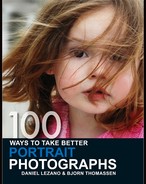Equipment for portraits
Although it is true that portraits can be taken using virtually any type of camera outfit, there are some that are particularly suited to the genre. You will find below our broad recommendations as to what we think are the best choices. We have assumed that you are like the majority of enthusiast photographers in that you are working to a budget. Therefore, we have chosen items that, as far as possible, are within the budgets of most people.

Before getting down to specifics, it is worth pointing out that we have centred our choices around digital cameras. That is not because we are anti-film; it is simply because sales of film cameras have been in massive decline in recent years and this trend is accelerating. Therefore, if you are considering buying new equipment, we would recommend that you opt for a digital outfit, which, compared to film, offers similar quality and numerous advantages, including instant review, easier post-production and reusable media.
Cameras
A digital SLR (DSLR) offers by far the best mix of versatility, quality and affordability. Even entry-level models offer resolutions ranging between 6 and 8 million pixels – more than good enough for 12×8in prints. Add to this an excellent range of features, such as multi-point autofocus, sophisticated metering patterns, integral flash and interchangeable lenses, and you have a camera that is both very capable and excellent value for money. Models such as the Canon EOS 30D are superb value, offering 8 megapixels, 35-zone evaluative metering and access to a huge system of lenses, flashguns and accessories.

Lens choice

Ideally, you should own a lens that covers a focal length of around 85mm (in 35mm terms), so the standard zoom that is supplied with a DSLR kit is suitable. You might also want to consider a telephoto zoom, as this offers extra creative possibilities, including candid photography. The other alternative is an ultra-wide-angle zoom. This can be used for unusual compositions as well as when you want to include much of the scene in the frame – for example, when taking environmental portraits.

Lens focal length
Because most DSLRs have a sensor that is smaller than a 35mm film frame (APS-C sensor), you usually need to multiply the stated focal length of the lens by a given ratio to find its 35mm equivalent. For instance, the sensor of most consumer DSLRs effectively requires you to multiply the lens’s stated focal length by 1.5× to find out how it equates to 35mm photography.
This is important, because lenses that are designed for DSLRs generally have a wider focal length than those made for film cameras. Let’s take standard zooms, for example. An 18–55mm ‘digital’ lens is equivalent to around 27–82mm (this is 18–55mm multiplied by 1.5×) in 35mm terms, while fitting a 28–80mm zoom lens designed for film cameras effectively becomes a 42–120mm zoom when used on a DSLR. The table below gives an indication of the effective focal length of a lens fitted on a consumer DSLR with an APS-C sensor.
Studio flash kits
While daylight offers a wealth of lighting options, studio flash cannot be matched for its level of control. A single flash head kit is adequate to begin with, but you should try to stretch to a two-head outfit. Budget kits are a good place to start, but invest a little more if you can, as more expensive heads offer more power, variable ratio control and faster recycling. Various brands are available; we would recommend Prolinca and Elinchrom, as they offer excellent performance and reliability. Most come supplied with a silver or white brolly, but it is a good idea to buy a softbox attachment as well.
Accessories
There are a number of accessories that a portrait photographer should consider essential. Reflectors are one; these are an inexpensive aid for controlling light. While useful in the studio, they are invaluable when used outdoors in daylight. The same can be said for diffusers, which can be used to produce flattering light in the harshest of conditions. Lastolite make an incredible range of reflectors and diffusers to suit all lighting situations, and come highly recommended.
Finally, despite the accuracy of a camera’s metering system, you cannot beat a good-quality light meter for taking perfect exposures. Buy a combined meter, which reads daylight and flash exposures. We both use Sekonic meters as they are very accurate and consistent.

